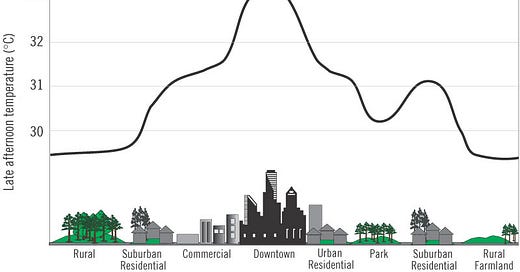[Back to the usual fare – with a question and sample answer. Remember my self-imposed limit of 600 words to reflect the time constraints of most A level specification essays. Commentary points are given at regular intervals, together with a summative commentary.]
To what extent do urban areas modify their climate? (20 marks)
Urban areas differ from their surrounding rural areas greatly as their temperature, amounts of precipitation, wind speed, and air quality are all affected. So, it is true that urban areas do modify their climate. I shall examine each of these aspects in turn. a
Temperature in urban areas is generally 1 or 2C warmer than the surrounding rural areas. This is due to the type of building materials used. Most buildings are made of dark, matt materials with a low albedo which absorb heat during the day and release it at night warming the atmosphere. Nighttime temperatures can be as much as 5 to 10C warmer than rural temperatures. Some modern building materials such as glass have a high albedo, and therefore reflect heat downwards on to the streets, also increasing air temperatures. In addition to building materials, industry and even people of which there are high densities in urban areas, emit heat. Air conditioning units, while cooling indoor temperatures, release heat into the atmosphere also. b
In addition to temperature, precipitation in urban areas is also increased. Anthropogenic heat, described above, leads to relatively low-pressure areas developing over cities. The warm air rises due to its low density and eventually the water vapour cools and condenses to form clouds and subsequent precipitation. In cities with significant air pollution problems, particulates released from industry and vehicle exhausts act as condensation nuclei for water droplets and therefore increase the rate of cloud formation. Urban areas can create their own thunderstorms due to the intense heat causing air to rise rapidly, forming huge cumulonimbus clouds upon condensation. These thunderstorms generally occur in the late afternoon or evening as the ground has received a large amount of insolation from the sun throughout the day. b
Conversely, the wind speed in urban areas is generally decreased. It can be up to 5% lower in the city centre than the suburbs due to the high density of uneven building heights. This increases the frictional drag between the air flow and tops of buildings slowing the wind speed. However, wind speed can be much higher in some parts of cities due to the venturi effect in urban ‘canyons’ which are long narrow streets parallel to the direction of airflow. The venturi effect is the effect of squeezing the airflow, which produces high velocities. These high wind speeds can sometimes blow over pedestrians. Bridgewater Place, the tallest building in Leeds, produces an unusual spiralling effect of the air around it, which blew over a lorry killing a man in 2009. c
Air quality is a lot worse in urban areas as factories and vehicles produce large amounts of pollutants such as carbon dioxide, sulphur dioxide and PM10s. These chemicals create a pollution dome which increase warming of the urban microclimate as they allow in solar radiation but trap outgoing thermal infrared radiation, preventing it from being radiated back into space. Photochemical smog formed by ultraviolet light reacting with hydrocarbons and oxides, produced by vehicle exhausts, is also common. London has tried to reduce such pollution with its ULEZ area (though many people have objected to it). d
It is clear therefore that urban areas do significantly modify their climates, in comparison to surrounding rural areas. Most of the modifications are not too damaging to people, except for air pollution. Although there are many policies in place to reduce the effects of pollution in urban areas, these policies cannot reduce these effects to zero because of the high concentration of industry in cities. Global economic systems and the character of the urban places themselves therefore also play an important role. e
18/20 marks awarded. This is a very methodical answer, which is both conceptually thorough and logical. The student begins with a clear statement of intent a. The following paragraphs then examine each aspect of climate (temperature, precipitation, wind speed and air quality) stated in the introduction with clear detail of process, and appropriate application to the question (b, c and d). One piece of case study material is also well-used – Bridgewater Place, Leeds. The London case study needs a little more elaboration. The lengthy conclusion addresses the question, but also introduces other factors that may play a role – a clear attempt to introduce synoptic ideas – governance, global systems and changing places e. A little more consideration of these elements earlier would have raised the answer to full marks.



